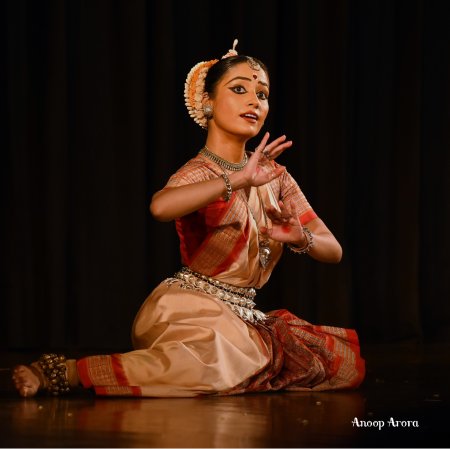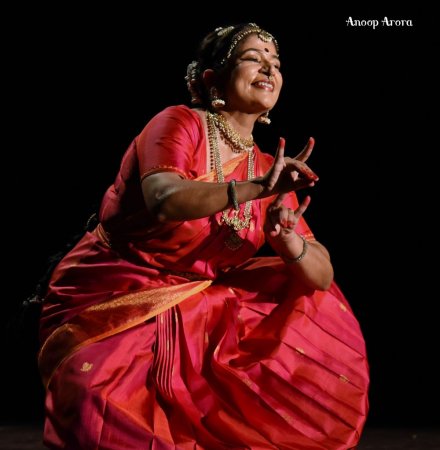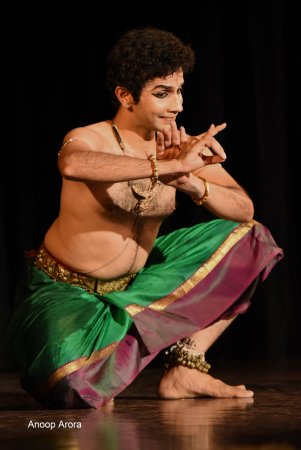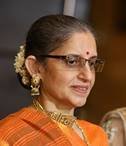
|   |

|   |
Natya Vriksha's World Dance Day celebration - Shveta Arora e-mail: arorashveta1806@gmail.com Photos: Anoop Arora July 6, 2023 In the last week of April, many dance institutions and organizations held programmes all over Delhi to celebrate World Dance Day 2023. There was so much going on that viewers were spoilt for choice. What held them back was only how much time they could spend commuting in a city like Delhi, where the traffic snarls are pretty nasty! The WDD celebrations organized by Natya Vriksha were held at the India International Centre on 22 and 23 April 2023. Geeta Chandran was the host and curator for the event, which began at 10am on both days with a workshop, followed by lecture-demonstrations, seminars and awards. Each evening culminated with performances by dancers from different forms of dance. Shalakha Rai's delicate yet agile Odissi  Shalakha Rai The first day's evening performance was by Odissi dancer Shalakha Rai, a disciple of Guru Madhavi Mudgal. Shalakha has completed Visharad Purna from Akhil Bharatiya Gandharva Mahavidyalaya Mandal, Mumbai, and teaches Odissi at the Gandharva Mahavidyalaya in Delhi. Dressed in a sandal coloured saree with a red border, she started with a pushpanjali and went on to do a Bihaag pallavi, a pure nritta piece. Shalakha was very graceful in her chauka and footwork. Her hastas were exact and she moved in circles all over the stage, taking full and half chakkars, back turns, leaps, footwork on heels, hands interlocked and moving in waves with expansive hand movements. She performed a plethora of moves, executed with grace and precision. The pleasant vocals, melody of the flute, the rhythm of the manjira and Shalakha's controlled moves gave the piece a very calming effect. The third piece was an ashtapadi, "Yahi Madhava yahi Keshava", from Geeta Govind by poet Jayadeva. Here, Radha is a khandita nayika who has waited all night for her beloved to come to her and when he comes at the break of dawn after spending the night with another, she is furious. The choreography was by Guru Kelucharan Mohapatra and the music by Pt Bhubaneswar Mishra. Shalakha began her depiction as the waiting Radha holding an earthen lamp in her hand. Tired, she puts it down and waits at the door. The lotus that had bloomed at sunrise has closed at sunset. In the first light of dawn, she sees him and runs to embrace him. But alas, she notices the tell-tale signs of last night's dalliance on Krishna's body. In disgust, she ignores his excuses and tells him to leave, shutting the door behind him. The abhinaya was subtle and emotive. The final piece was "Braja ku chora aasichi", an Odissi song wherein mother Yashoda is trying in vain to put baby Krishna to sleep in the crib but he runs away. She goes after him, gets him and carries him on her back. She tries to scare him by saying that the thief will come and take him away. He will come flying and he will have a big beak. He might be like a bull with horns, or he might come in the form of an elephant, or he might disguise himself and carry Krishna away. Ma Yashoda holds up her child and compares him to the moon - gokula chandrama. She then shuts the door and tries to pacify him to sleep. He runs to pick up mud and eat it. He pulls her hair from behind. She picks him up and plays with him, cuddles him and puts him to sleep in the crib. She looks at him and takes a balaiyan (a gesture to avert evil gazes). It was subtle abhinaya done in an unhurried manner, with poise and, of course, with the love of a mother. This was followed by chants from the Rigveda and moksha in very energetic and agile nritta. She ended her performance with an ode to the entire creation and prakriti, prostrating herself before the Almighty. Her guru Madhavi Mudgal recited the bols on manjira. Megha Shirodkar on the vocals had a sweet timbre (this was her debut performance), Ganesh Singh was on the flute (his debut also) and Yaar Mohammad on sitar. Shalakha presented a graceful performance with ease of movement, precision in her hastas and agility in her footwork. She embodied the rhythm of her form and covered the stage with expansive movements. Divya Devaguptapu creates ecstasy with sterling recital  Divya Devaguptapu The second dancer to perform on day one was Bharatanatyam dancer Divya Devaguptapu, a senior disciple of the Dhananjayans, who practices and teaches dance in both Chennai and California. She is a critically acclaimed dancer whose performance at the WDD celebrations was uniformly hailed. Sometimes, one feels that in a performance of this calibre, it becomes more of an experience rather than simply sitting and seeing a classical dance performance. The dancer becomes a sadhaka and the audience becomes one with the dancer. It is a direct transmission of emotions from the dancer to the audience, with moments of epiphany on both ends. This is the result of her gurus teaching her to meditate on the piece and then think of the abhinaya. Divya dazzled in her red aharyam and jewellery that glittered, particularly the nose ornament that she wore. The performance was titled 'Sambhoga X'. The composition was by Oothukkadu Venkata Kavi in raag Kalyani, taal adi. Introducing the piece, Divya said that according to 'Bhaja Govindam', whatever path we take, whether bhoga or yoga, the ultimate goal is union with the divine. Between them is the path that we traverse with our ego, thoughts and emotions, which create hurdles, which is the X. The piece is about the union of Radha and Krishna, Krishna being the ishwar and Radha the ehladini shakti or the power of Krishna's love. It is the celebration of the divine union of static and dynamic energy, spiritual and sensual love. Divya began in a seated pose, reclining on her side, as Radha. Every pore of her body exuded the bhava of Radha. Ranjini started her vocals on a gentle note with the lyrics "Madhava hridikhelini," the one who resides in the heart of Madhava. Divya, with her head bowed and a gentle smile on her face, tapped one foot gently and her ghunghroos made a soft sound. The sound of the flute that Radha hears sends waves of emotions through her body. The Lord resides in the vast ocean, reclining on the coiled serpent. Radha is the one who hears the flute music and is totally immersed in the bliss of it. She resides in the bower, where the flowers with sweet scents are blooming. Krishna is wearing the peacock feather and playing on his flute, the creepers twining, flowering and drooping. As Divya sat with her back to the audience in a squat, swaying, the lights dimmed and the music flowed in soft notes. The experience was almost like hearing the brahmanaad. The music from the flute is heard by the calf that listens and looks lovingly at Krishna. The peacock was shown in a broad plie, moving and offering its feather to Krishna. The sound of the flute enamours all living beings in creation. Radhe rasyut raasvilase: she embodies the rasa as she gets filled with the rasa. Divya, as a very poised Radha then plays the dandiya in raas leela, covering the stage with her footwork. As Radha sits down to braid her hair, she sees Krishna in the mirror and feels his arms wrapping around her in an embrace. Radha is the ruling queen of the kingdom of Krishna's love. Krishna hovers on her like a bee on a lotus. A garland beautifies her neck. She is the beloved of the one who vanquished Bakasura. Radha looks at him from behind her veil to admire his smile. She is the queen of the one who lifted the Govardhan with ease, and his flower garlands swing when he dances with the flute. The bangles in the lotus hands glitter as they clap to give a rhythm. During lovemaking (rati samaye), the earrings in their beautiful ears brush their cheeks as they hear the rasa-filled words spoken by the other. With an aalaap in the vocals, Divya spread out her hands while taking chakkars, showing the bliss the leela is spreading in the entire creation. Radha and Krishna dance with the young and beautiful gopis and the sound spreads. Divya showed Krishna making Radha sit and applies aalta to her feet. They finally unite into one, the super soul, a performance that could give you goose bumps. The composition was a rare one since not many are an ode to Shri Radha. Add to that the wonderfully composed music, the vocals in Ranjini's melodious voice, and top it all with Divya's training, which she said later was more like a process in meditation, and her bhavas, which were a mirror to her soul. The entire mix was heady and soul-stirring. The piece was performed in the varnam format with nritta interludes. The rhythm and pace of the nritta sections were brilliant. The hastas were expansive and exact. Her raas leela covered the stage and her mastery of her technique was apparent. Each time she would come to a sam of the nritta, her footwork was packed with power. The entire piece had everything that a wholesome piece would have: lyrics, music, percussion, vocals and the experience of bhakti and bliss through dance. The padam portrayed the X in the production. She said that padams require silences and patience to understand, and that she was particularly fond of them for their relatability to life experiences. It was a padam in raag Bhairavi, a composition of Kshetrayya. The nayak has returned late and gives his excuses. The nayika is a strong-headed woman who knows that her lover is emotionally na´ve and would not understand her state of mind. Divya's depiction of the varied emotions of the nayika was an experience to watch. The nayak knocks and walks in through the door of his house. The nayika asks him to sit and offers him water. She opens the window and sits near it, looking at him scornfully. She tells him that during her heyday, his love for her was different. He would sing praises of her beauty and chase after her. He wrote long letters to her expressing his love and now he has no concern for her emotions. Now that he has no choice, he had better sit and watch her cry. Divya's expressions suggestive of the anger seething inside, was a class in abhinaya. The next piece titled 'Samyoga' was a Kabir bhajan in raag Basant Bahar. The composition was by Ranjini and had evolved from an exchange of ideas between her and Divya. The piece was done in the thillana format, starting with percussion and jatis. The rhythm and notes employed by Ranjini and the violinist were very tuneful. Divya depicted the concept through expansive nritta. In the abhinaya, she depicted the distraught human soul, which is foolish to go to various places of worship, looking for the union in idol worship or in performing namaz, and yet is empty-handed and left rubbing its hands. When it looks inside itself, breaks the shackles of rituals, the kundalini rises and its quest ends in finding god in the sea of its own breath. What an exhilarating journey Divya took the audience on! She herself experienced that bliss as she danced and the viewers too joined her in that journey. As Rajiv Chandran exclaimed, 'What we have just seen is not a performance but a point of view.' Divya was accompanied by Ranjini Ramakrishnan on vocals, Jayshree Ramanathan on nattuvangam, K.P. Ramesh Babu on mridangam, K. Shrijith on violin and Milind Shrivastava on lights. Pavitra Bhat defines stage presence and coverage  Pavitra Bhat On the second day, the first performer for the evening was Madhusmita Raut in Manipuri, but I was unable to catch her performance. The second dancer was established soloist, choreographer and teacher Pavitra Krishna Bhat, a disciple of Guru Deepak Mazumdar. Pavitra is a well-known and highly regarded name in Bharatanatyam and each time I watch him, he emerges better and more perfect. After an alarippu, he did a varnam by the Tanjore Quartet in raag Chakravak, adi taal. Here, the nayika is pining for Lord Brihadeeshwara. She tells the lord that she pines for him like the lotus for the sun, like the chakravaka for the moon, the fish for the sea. She is overwhelmed by the cries of the cuckoo and the constant humming of the bees. The abhinaya for the lovelorn nayika was sensual and subtle. At times, she denies her feelings and at other times, tells the lord to look at the lotuses blooming in the pond, the fish in the water and the chakravaka. The cooing of the birds and the creeper entwined on the trees aggravate her longing as she climbs the steps to the temple. Shiva dazzles her with the rays of the moon and as she forcibly opens her eyes, she has a moment of epiphany. The darshan of Brihadeeshwara with snakes wound around him, the moon on his head and the sound of the damru leave her spellbound. The emotions rise and subside like waves in her pining heart. Madana comes with the arrows of flowers and shoots them at her. Her throat is choked with emotions. She dreams of the lord arriving on his Nandi and begs Madana to shoot his arrows at the lord. Madana picks five flowers with different scents and shoots them at Shiva, who is unmoved, and then he gives up since he knows that Shiva is capable of turning him to ashes if he opens his third eye. Pavitra presented a wonderful portrayal of the indifferent lord and the overly desirous nayika. But it is nritta that makes a mark when you watch Pavitra dancing. Suddenly, he is transformed into a taller person and when he spreads his arms, you feel he looks like a broader person too - such is the expanse and power of his movement. The footwork adds an extra punch. His hand and arm movements have a chiselled quality and he finishes each posture completely. The stage coverage is so vast that in one move, he completes left, right, back and forth, moving from the back of the stage to the front edge, diagonally to and forth in a leap. His leg lifts are perfect and well-balanced. He squats with ease and then turns back with one leg outstretched. The rhythm of his footwork, whether in tandem or alternating, is noteworthy. For the conclusion, Pavitra performed a shloka as an ode to Lord Krishna and a Surdas pada, "Hey Govind Hey Gopal." Krishna is the jewel of the eyes of the gopis. He is the protecter of the three worlds, but for the gopis he is the chaatak mani (the beloved), for Rukmini he is the bhushan mani (her jewel), for gopal the choodamani (leader). With expansive movements, Pavitra danced Krishna carrying his cowhered staff on his shoulders and roaming in Vrindavan. He caresses his calves and cows as he herds them in Giriraj mountain. For the Surdas pada, Pavitra depicted the gaja uddhar (liberation of the elephant). The elephant was roaming the riverbank, bathing and drinking water, unaware of the looming crocodile in the water. They fought endlessly but the elephant could not free his foot from the mouth of the crocodile. It is when he is being helplessly dragged that he calls out for Krishna to help. The lord is reclining on the celestial snake and his steed Garuda is preening its feathers. It is Pavitra's favourite act of showing Garuda preening his feathers and flexing his arms standing in broad plie. But Krishna does not even wait for his steed and reaches to save the elephant from the clutches of the crocodile and gives moksha to the crocodile. It was an impeccable abhinaya, with Pavitra portraying the tale with all its nuances. And so the blind bhakta searches for his quill and leaf, picks them up and writes to the lord that maybe it is his turn to be granted the lord's kindness and be blessed. It was for more than an hour that Pavitra danced without diminishing energy and stamina. The athleticism and mastery of his technique are remarkable. Kudos to his team of accompanists: K. Venkatesh for the soulful vocals, besides Manohar Balatchandirane, Raghavendra Prasath and Udayasankar Lal. The entire festival was a big success thanks to the efforts of Geeta Chandran, Rajiv Chandran and the entire Natya Vriksha team. The lifetime achievement award was conferred on Kamalini Dutt, a truly dedicated and revered guru in the dance world.  Shveta Arora is a dance-mad writer who chronicles classical dance events in Delhi (and also those online). In 2009, she started the blog Kala Upasana at delhiculturecomment.blogspot.com, where she began posting her own writing along with photographs clicked by Anoop Arora, her husband. She's been dancing all her life as a devotee, but resumed her formal training in Kathak in her 50s and has passed her fifth year Kathak exams. |